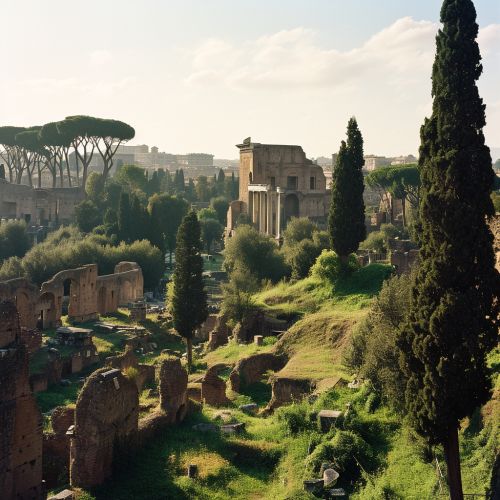Palatine Hill
Overview
The Palatine Hill, known in Latin as 'Collis Palatium', is one of the seven hills in Rome, Italy. It stands 40 meters above the Roman Forum, looking down upon it on one side, and upon the Circus Maximus on the other. It is the centremost of the Seven Hills of Rome and is one of the most ancient parts of the city. The Palatine Hill is a significant location in Roman mythology, believed to be the location where the city of Rome was founded.
Geography
The Palatine Hill is located between the Velabrum and the Roman Forum, two of the most ancient parts of the city. The hill is composed of tufa, peperino, and other volcanic materials. It was originally a high and steep hill, but over time, the sides of the hill were terraced and made more habitable. The top of the hill is a plateau, providing space for the construction of buildings and palaces.


History
The history of the Palatine Hill is deeply intertwined with the history of the city of Rome itself. The hill was inhabited as early as the 10th century BC and was the site of the earliest Roman settlements. According to Roman mythology, the Palatine Hill was the location where Romulus and Remus, the legendary founders of Rome, were found by the she-wolf that kept them alive. Romulus, who became the first king of Rome, is said to have started building the city of Rome on the Palatine Hill.
During the Republican Period, the Palatine Hill was a desirable residential area. Many affluent Romans, including Cicero, built their homes on the Palatine. During the Imperial Period, the hill became the exclusive domain of the emperors, and several palaces, including the Palace of Domitian, were built on it.
Archaeological Significance
The Palatine Hill is of great archaeological significance. Excavations on the hill have revealed remains from the Iron Age as well as the Roman Republic and Roman Empire. Some of the most significant archaeological finds include the remains of the Palace of Domitian, the House of Livia, and the House of Augustus. The Palatine Museum, located on the hill, houses many of the artifacts found during these excavations.
Tourism
Today, the Palatine Hill is a major tourist attraction. Visitors can explore the ruins of the ancient palaces and enjoy panoramic views of Rome. The hill is also home to the Farnese Gardens, one of the oldest botanical gardens in Europe.
